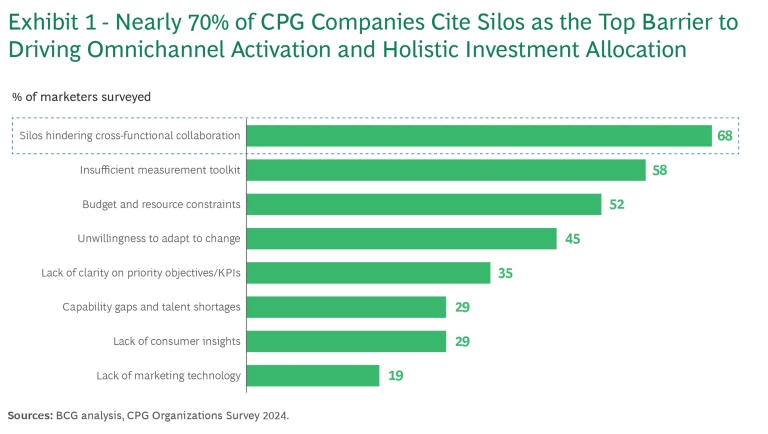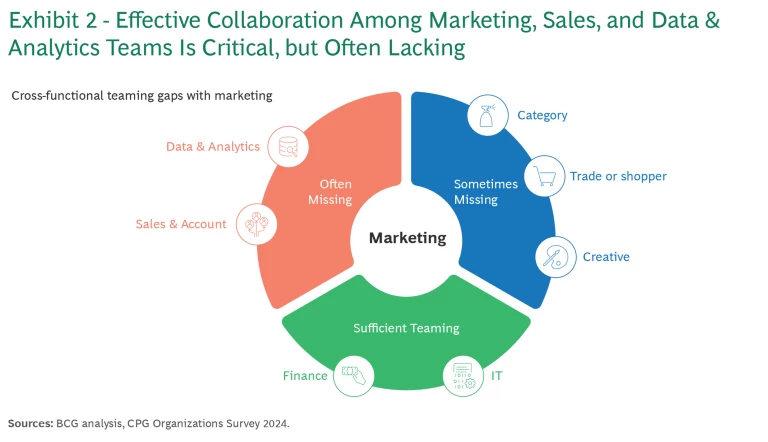The evolution in consumer experience that brought us from TV ads and weekly supermarket trips to the explosion of media touchpoints and purchasing pathways that exists today has been underway for nearly two decades. Yet many consumer packaged goods (CPG) companies still rely on sales and marketing models that have not caught up with these new realities.
In an environment where consumers expect personalized, consistent engagement across online and offline channels, the divisions between sales and marketing have blurred. Companies dependent on the siloed sales and marketing model that worked well in the past are not equipped to conduct efficient, integrated omnichannel activities that are necessary to compete in today’s market.
A recent BCG survey found that 75% of CPG marketing leaders said omnichannel investment allocation and activation are their biggest challenges. Of those who gave this response, 68% said that organizational silos and poor internal collaboration are the biggest hurdles to overcome. (See Exhibit 1.)

These findings suggest that significant opportunities to improve competitiveness are available to those who can rethink the traditional model and harness the power of integrated, data-driven strategies. From BCG’s experience working with clients, companies that redefine their marketing and sales operating model as part of a broader marketing effectiveness initiative can achieve potential improvements—such as a 3% to 6% rise in revenue or a 30% increase in return on marketing investment.
In today’s complex marketing environment, consumer touchpoints have proliferated, collapsing the traditional consumer purchase journey funnel as sales and marketing activities become more fragmented and less effective. Companies need to adapt to this new environment with an approach to targeting, messaging, media buying, promotion, and in-store activation that is coordinated across marketing, sales, media, and analytics teams.
It’s a difficult task. Marketing and sales functions share similar goals but have different timeframes, capabilities, and access to information. They both typically work well with finance and IT; however, marketing often fails to partner sufficiently with data and analytics and sales and account teams—areas where collaboration is required to achieve desired outcomes. (See Exhibit 2.)

An example is retail media, which the sales team tends to handle as part of managing the retailer relationship. Marketing also must have a say in retail media activities due to their role in brand campaigns. The two functions need to work together to optimize retail media to drive business outcomes and foster strong retailer relationships.
Thus, the non-integrated approach is a liability these days because it causes companies to miss opportunities to respond quickly to market shifts, share insights, and effectively use the huge amount of data available through online platforms, social media, and in-store analytics. Companies that take a coordinated approach to the consumer experience can achieve stronger market insights and use them to create more impactful, customized interactions across marketing channels.
A few CPGs have gotten it right when it comes to some of these key challenges. BCG has identified four hallmark principles that have been important contributors to those who have made the transition successfully.
- Representation from key cross-functional stakeholders
- Consistent process for execution
- Clear governance
- Aligned incentives that promote collaboration
A good way to understand these success factors is to look at examples of companies that have made these improvements.
Improving cross-functional stakeholder representation through a pod approach
Leaders at a global CPG company were frustrated that campaign planning and execution were moving slowly while still not reflecting an integrated view of the consumer. Marketing, media, and account teams were not sharing data and were not able to develop campaigns appropriate for modern consumer journeys.
To break down the siloed operating model, the company created collaborative activation pods—structured cross-functional teams with clear roles. The pod model eliminated siloed decision-making and aligned the team around agreed commercial objectives. Instead of teams working on separate strategies, cross-functional pods were able to drive new growth through an integrated marketing plan. The result was faster speed-to-market, more cohesive brand planning, and more personalized engagement across the customer journey .
Establishing consistent process and clear governance by unifying campaigns under a brand leader
Another global CPG company was struggling with poorly coordinated sales and marketing teams and was losing market share as a result. Brand campaign responsibilities were divided among functional teams, including sales, analytics, finance, and trade. The approach was inefficient and lacked accountability across functions, leading to missed inputs and disjointed planning.
To address the problem, the company installed a single leader to oversee brand campaign planning across the functional teams, with accountability for delivering plans on time, and placed cross-functional leads at decision points. The new structure streamlined the planning process by establishing clear milestones, expectations, and mandatory participation for key leaders.
The clearer governance structure and processes helped bring teams together and has enabled more aligned and cohesive campaigns that deliver against business objectives. Another benefit is faster speed-to-market due to streamlined, centrally managed planning. The improved coordination also enhanced the customer experience by aligning cross-functional efforts across channels more effectively.
Next Steps on the Path to a Collaborative Sales and Marketing Model
Although the miscues and inefficiencies caused by silos may be readily apparent, the changes—and implementing them so they stick—are difficult for most companies. Unfortunately, many companies reach for technology or data and analytics solutions without making complementary changes in the way the organization supports collaboration and decision-making.
However, redrawing the organizational lines and boxes is usually not enough. Companies must also implement supporting mechanisms—such as decision rights, governance, collaboration forums, and incentives—that help teams work together effectively.
The traditional sales and marketing model that worked well for consumer products companies in the past is failing in the evolving multi-platform, omnichannel environment. As multiple digital platforms transform the market environment, blurring the lines between sales and marketing, companies are struggling to execute effective brand and sales tactics across online, retail, and mobile channels. Companies can successfully bridge the transition by developing a more integrated operating model focusing on four improvement areas: representation of key stakeholders, clear process for execution, defined governance and aligned incentives.












